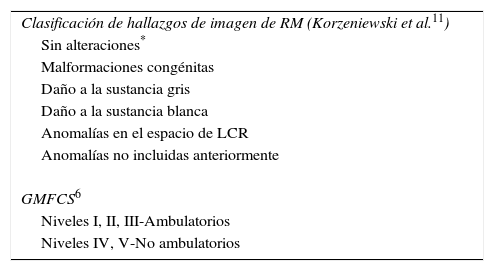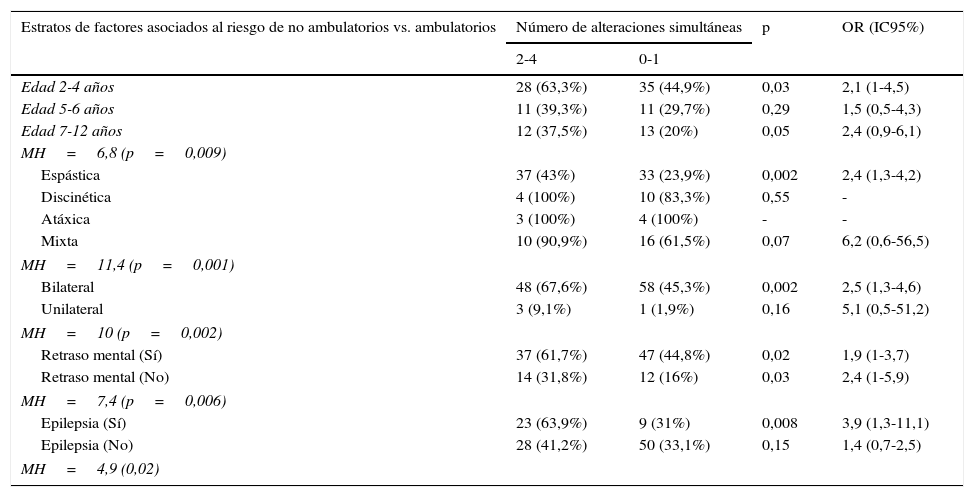Parte esencial de la evaluación diagnóstica de la patogénesis y la severidad de las lesiones cerebrales en la parálisis cerebral (PC) es la realización de estudios de neuroimagen. El objetivo de este estudio es identificar los hallazgos de resonancia magnética (RM) y la probable asociación con los niveles de automovilidad de acuerdo al Sistema de Clasificación de la Función Motora Gruesa.
Pacientes y métodosEstudio transversal, descriptivo, observacional en 284 estudios de RM de cráneo de niños con diferentes formas clínicas de PC (174 sexo masculino, 110 femenino; 2-12 años de edad). Los hallazgos se agruparon de acuerdo al número de alteraciones por RM. Clínicamente se clasificaron de acuerdo al déficit motor, afección topográfica, nivel ambulatorio y presencia o no de trastornos cognitivos y sensoriales asociados. Análisis estadístico descriptivo, χ2, odds ratio y regresión logística binaria.
ResultadosLas formas espásticas y mixtas tuvieron mayor proporción de hallazgos combinados (p=0,0001); los pacientes no ambulatorios tuvieron una odds ratio de 1,9 (IC95%: 1,2-3,2) mayor que los ambulatorios de presentar 2-4 hallazgos combinados (p=0,009). El grupo no ambulatorio con 2-4 hallazgos por RM se relacionó con una mayor prevalencia de trastornos asociados.
ConclusionesExiste relación directa entre la magnitud de la afectación cerebral encontrada por RM y el estatus ambulatorio de los pacientes con PC. Los resultados de RM en niños con PC son comúnmente anormales y pueden ayudar a determinar la etiología y severidad de la lesión cerebral y generar implicaciones para el asesoramiento y estrategias de intervención.
Neuroimaging is an essential tool in the diagnosis of the pathogenesis and severity of brain damage in cerebral palsy (CP). The objective of this study was to identify cranial magnetic resonance imaging (MRI) findings and their possible association with automobility levels according to the Gross Motor Function Classification System.
Patients and methodsCross-sectional, descriptive, observational study of 284 MRI tests in children diagnosed with CP (174 boys, 110 girls; age 2-11 years). The findings were grouped according to the number of alterations detected on MRI. Clinical forms were classified according to the motor deficit, topographic condition, ambulatory level and the presence or absence of cognitive and sensory disorders. A descriptive statistical study was performed with the χ2test, odds ratio and binary logistic regression.
ResultsSpastic and mixed forms of CP had a higher proportion of combined abnormal findings (P=.0001), non-ambulatory patients had an OR 1.9 (95% CI 1.2-3.2) higher than outpatients presenting 2-4 combined findings (P=.009). The non-ambulatory group with 2-4 MRI findings was associated with a higher prevalence of associated disorders.
ConclusionsThere is a direct relationship between the extent of cerebral involvement identified on MRI and the ambulatory status of patients with CP. The results of MRI in children with CP are commonly abnormal and can help determine the aetiology and severity of brain injury and generate implications for counselling and intervention strategies.
Artículo
Comprando el artículo el PDF del mismo podrá ser descargado
Precio 19,34 €
Comprar ahora











